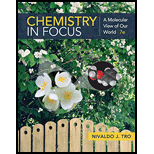
Interpretation:
The four types of contaminants that are found in water with two examples each are to be listed.
Concept Introduction:
Water is a common liquid that is present on the Earth.
It is also known as universal solvent. It can dissolve a wide range of organic and inorganic solutes.
Water is vital for the existence of all living animals. Without water, no life form can exist, it constitutes an important part of rivers, lakes, streams, clouds, snow and ice.
Water is truly an unusual molecule such that being a low molar mass compound, it exists as a liquid at room temperature and has an anonymously high boiling point.
Ice floats on water because it has a lower density than water.
Water contains some unwanted particles which can lead to diseases and other hostile effects on human health.
Water acts as a good solvent, so numerous particles and microbes can contaminate water.
Biological contaminants: Some microbes can live in water and can cause various diseases like cholera, dysentery, and so on. Two examples of such microbes are Giardia and Legionella.
Inorganic contaminants: Some inorganic molecules can dissolve in water and make it impotable (not suited for drinking). Two examples of such molecules are Nitrates and Asbestos.
Organic contaminants: Some organic molecules can dissolve in water and makes it impotable (not suited for drinking). Two examples of such molecules are chlorohydrocarbons (volatile) and ethylbenzene (non-volatile).
Radioactive contaminants: Some radioactive elements can dissolve in water and make it impotable (not suited for drinking). Two examples of such elements are Uranium and Radium.
Want to see the full answer?
Check out a sample textbook solution
Chapter 12 Solutions
Chemistry In Focus
- Make these conversions for atmospheric concentrations: (a) CO: 35 ppm to percent; (b) NO2: 0.053 ppm to ppb.arrow_forwardThe maximum safe level of each compound in drinking water is given below. Convert each value to parts per million. a. chloroform (CHCl 3, a solvent), 80 μg/kg b. glyphosate (a pesticide), 700 μg/kgarrow_forwardWhat category of environmental chemistry that deals with chemical phenomena in all types ofwater and natural waters?arrow_forward
- Compare and contrast chlorinity and salinity. What is/are the importance of measuring water salinity?arrow_forward92.56 grams of mercury have contaminated a drinking water source with a volume of 7.5x105 m3. Does this mercury concentration fall below the EPA's maximum contaminant level?arrow_forwardIf a sample of water is being determined to contain 389 ppm of lead, how many g of lead does one gallon (1 gal = 3785 g of water) of this lead contaminated water contain? Round your answer to 4 decimal digits.arrow_forward
- Which solution is placed inside the buret? NaOH O vinegar O water OKHParrow_forwardA solution of atrazine (an herbicide) in water has a concentration of 0.050 µg/L. What is this concentration in units of ppb? Assume a solution density of 1.00 g/mL.arrow_forwardWhich chemical or functional group helps a molecule dissolve in water? NH2 (amino group) fats hydrocarbon tails (side chains) CH3 (methyl group)arrow_forward
- The maximum safe level of each compound in drinking water is given below. Convert each value to parts per million. a. chloroform (CHCl3, a solvent), 80 µg/kg: b. glyphosate (a pesticide), 700 µg/kg: ppm CHC13 ppm glyphosatearrow_forwardThe maximum safe level of each compound in drinking water is given below. Convert each value to parts per million. a. chloroform (CHC13, a solvent), S0 ug/kg: ppm CHCI3 b. glyphosate (a pesticide), 700 ug/kg: ppm glyphosatearrow_forwardCan distillation process be used to convert muddy water to potable water? Explain why.arrow_forward

 Introductory Chemistry: A FoundationChemistryISBN:9781337399425Author:Steven S. Zumdahl, Donald J. DeCostePublisher:Cengage Learning
Introductory Chemistry: A FoundationChemistryISBN:9781337399425Author:Steven S. Zumdahl, Donald J. DeCostePublisher:Cengage Learning Chemistry: The Molecular ScienceChemistryISBN:9781285199047Author:John W. Moore, Conrad L. StanitskiPublisher:Cengage Learning
Chemistry: The Molecular ScienceChemistryISBN:9781285199047Author:John W. Moore, Conrad L. StanitskiPublisher:Cengage Learning Chemistry: Principles and ReactionsChemistryISBN:9781305079373Author:William L. Masterton, Cecile N. HurleyPublisher:Cengage Learning
Chemistry: Principles and ReactionsChemistryISBN:9781305079373Author:William L. Masterton, Cecile N. HurleyPublisher:Cengage Learning Chemistry for Today: General, Organic, and Bioche...ChemistryISBN:9781305960060Author:Spencer L. Seager, Michael R. Slabaugh, Maren S. HansenPublisher:Cengage Learning
Chemistry for Today: General, Organic, and Bioche...ChemistryISBN:9781305960060Author:Spencer L. Seager, Michael R. Slabaugh, Maren S. HansenPublisher:Cengage Learning




